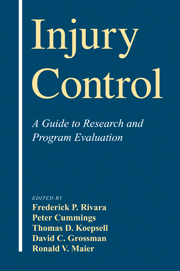Book contents
- Frontmatter
- Contents
- List of Contributors
- 1 An Overview of Injury Research
- 2 Classifying and Counting Injury
- 3 Measurement of Injury Severity and Co-morbidity
- 4 Data Linkages and Using Administrative and Secondary Databases
- 5 Rates, Rate Denominators, and Rate Comparisons
- 6 Data Collection Methods
- 7 Selecting a Study Design for Injury Research
- 8 Qualitative Methods in Injury Research
- 9 Randomized Trials
- 10 Cohort Studies in Injury Research
- 11 Case–Control Studies in Injury Research
- 12 Ecologic Studies
- 13 Case Series and Trauma Registries
- 14 Systematic Reviews of Injury Studies
- 15 Evaluating an Injury Intervention or Program
- 16 The Development of Clinical Decision Rules for Injury Care
- 17 Trauma Performance Improvement
- 18 Measuring Disability and Quality of Life Postinjury
- 19 Economic Evaluation of Injury Control
- 20 Ethical Issues
- Index
15 - Evaluating an Injury Intervention or Program
Published online by Cambridge University Press: 16 October 2009
- Frontmatter
- Contents
- List of Contributors
- 1 An Overview of Injury Research
- 2 Classifying and Counting Injury
- 3 Measurement of Injury Severity and Co-morbidity
- 4 Data Linkages and Using Administrative and Secondary Databases
- 5 Rates, Rate Denominators, and Rate Comparisons
- 6 Data Collection Methods
- 7 Selecting a Study Design for Injury Research
- 8 Qualitative Methods in Injury Research
- 9 Randomized Trials
- 10 Cohort Studies in Injury Research
- 11 Case–Control Studies in Injury Research
- 12 Ecologic Studies
- 13 Case Series and Trauma Registries
- 14 Systematic Reviews of Injury Studies
- 15 Evaluating an Injury Intervention or Program
- 16 The Development of Clinical Decision Rules for Injury Care
- 17 Trauma Performance Improvement
- 18 Measuring Disability and Quality of Life Postinjury
- 19 Economic Evaluation of Injury Control
- 20 Ethical Issues
- Index
Summary
Introduction
Evaluation is defined by Last's Dictionary of Epidemiology as a “process that attempts to determine as systematically and objectively as possible, the relevance, effectiveness, and impact of activities in light of their objectives. Several varieties of evaluation can be distinguished; e.g., evaluation of structure, process, and outcome.” (Last et al., 1995).
No single definition captures all the aspects of program evaluation. Evaluation research shares some themes with outcomes research and with efforts to measure the quality of healthcare (Petitti, 1998; Petitti and Amster, 1998). With outcomes research, it shares a focus on effectiveness (intervention under everyday circumstances) more often than on efficacy (the effect of the intervention under ideal and tightly controlled conditions). With quality of care research, it shares the use of structural, process, and outcome (health effects) measures to examine program/intervention effects.
We emphasize the importance of linking an intervention with an evaluation plan at the outset. Without this linkage, it is often impossible to design an evaluation post hoc that will provide valid process and outcome information.
Performing Program Evaluation
Purpose of Evaluation
Evaluation is often described as having one or more of three purposes: (1) to establish or clarify program effectiveness; (2) to improve program implementation; and (3) to address administrative needs. This chapter addresses the first two purposes. Generally evaluation indicates how effectively the program was implemented (process), what it has accomplished (outcomes), and how effective it was for health (outcome) (Dannenberg and Fowler, 1998; Thompson and McClintock, 1998).
By working with the program's stakeholders, one should generate a list of the speciic questions to be answered by the evaluation.
Keywords
- Type
- Chapter
- Information
- Injury ControlA Guide to Research and Program Evaluation, pp. 196 - 216Publisher: Cambridge University PressPrint publication year: 2000

